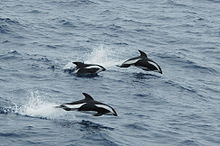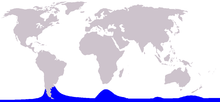Hourglass dolphin
| Hourglass dolphin | |
|---|---|
 |
|
| Hourglass dolphins leaping in the Drake Passage | |
 |
|
| Size compared to an average human | |
| Scientific classification | |
| Kingdom: | Animalia |
| Phylum: | Chordata |
| Class: | Mammalia |
| Order: | Artiodactyla |
| Infraorder: | Cetacea |
| Family: | Delphinidae |
| Genus: | Lagenorhynchus |
| Species: | L. cruciger |
| Binomial name | |
|
Lagenorhynchus cruciger (Quoy & Gaimard, 1824) |
|
 |
|
| Hourglass dolphin range | |
The hourglass dolphin (Lagenorhynchus cruciger) is a small dolphin in the family Delphinidae that inhabits Antarctic and subantarctic waters.
The dolphin has rarely been seen. It was identified as a new species by Jean René Constant Quoy and Joseph Paul Gaimard in 1824 from a drawing made in the South Pacific in 1820. It is the only cetacean to have been widely accepted as a species solely on witness accounts. By 1960, despite decades of whaling in the Southern Ocean, only three specimens had been recovered. As of 2010 only 6 complete and 14 partial specimens had been examined. Further information was obtained from 4 strandings and boats which searched for the dolphins in areas rarely visited by ships.
Though it is traditionally placed in the genus Lagenorhynchus, recent molecular analyses indicate that the hourglass dolphin is actually more closely related to the dolphins of the genus Cephalorhynchus.
The hourglass dolphin is colored black and white and sometimes variations of dark grey. For this reason, it was colloquially known by whalers as a "sea cow". Each flank has a white patch at the front, above the beak, eye and flipper, and a second patch at the rear. These two patches are connected by a thin white strip, creating, loosely speaking, an hourglass shape; hence the common name of the dolphin. The scientific name cruciger is Latin for "cross-carrier". This refers to the area of black coloration, which, viewed from above, vaguely resembles a Maltese cross or cross pattée. The color of calves is not known since there's no reports up to date of any sighting.
...
Wikipedia

